Liz Lambert has displayed powers of transformation from the very beginning. When she renovated her first property, the Hotel San José, in the late nineties, she presented a look that came to define the modern Austin aesthetic: groovy environments that felt layered yet minimal, with cacti, Bolivian blankets, and highly polished concrete floors. In short order, copycats sprang up all over town, and with the Hotel San José as an anchor, South Congress Avenue morphed from a crime-ridden strip into one of the most vibrant, commercially booming streets in Texas.
Her legend had only begun. Nowadays, seven deep into a collection of distinctive properties managed by her hospitality company, the Bunkhouse Group, Lambert has become an international force behind the boutique-hotel movement of the past decade. Her discerning selections launch trends. Take the fifties-era Acapulco chair. It’s everywhere you look—porches and border cafes—because Lambert brought it back in style. While working on the Thunderbird, in Marfa, in 2004 (she has not been involved since late 2006), Lambert journeyed to the city of Oaxaca, where she’d spotted the colorful pear-shaped chairs years before. She scoured the town, talking to area craftspeople and finally learning that the maker might be in nearby Puerto Escondido. Never one to give up easily, she boarded a tiny plane to track down the chair builder.
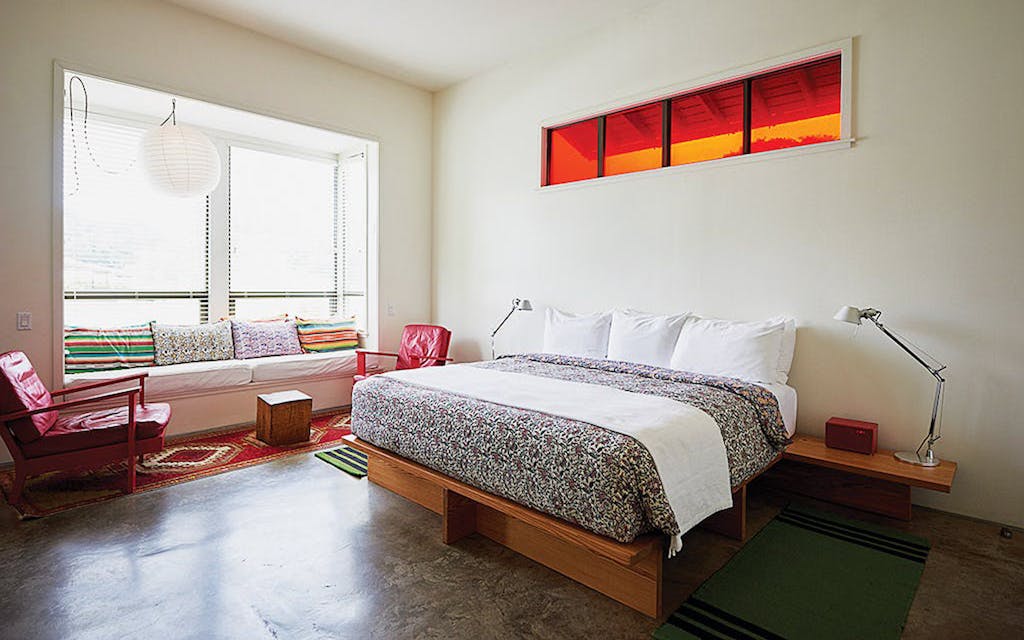
“No one in the U.S. was making them. It took days to track down the one guy who made them, thirty miles outside [Puerto Escondido]. I ran down the street after his truck trying to catch him to buy some for the hotel,” she remembers. Lambert bought about a hundred chairs for $20 each and had the batch driven up the coast of Mexico to Texas, to rest on the porches of the hotel and around the pool. Now you can buy an Acapulco chair from just about any Pier 1 Imports.
In the coming months, Bunkhouse will unveil a renovated Phoenix Hotel in San Francisco, a yet-to-be-named motor inn in Atlanta, and a five-story hotel in Austin called the Magdalena, with more projects in the works. Here are some of our favorite Lambert touches—and the stories behind them.
The Furniture at the Hotel San José
“Repetition of a few elements can create that sense of calm in a place,” Lambert says. “I start by carefully selecting a handful of things, then I use them as a language throughout the space.”
At the Hotel San José, a minimalist Japan-meets-lush-Mexico vibe is delivered using sparse decor and an olive-green color palette with tomato-red accents, but it’s the warm, longleaf pine furniture that serves as the ultimate unifying force. In 1998, when Lambert set out to redesign the hotel after running it as a $30-a-night motel for three years (often working at the front desk herself), good design tools weren’t readily available. There wasn’t an influx of shelter magazines or specialty stores, and she wasn’t going to place a mass order of case goods from China for the forty rooms in her hotel, all of which had different floor plans. So she got together with Marfa-based furniture maker Jamey Garza and architect Bob Harris, from the celebrated San Antonio–based architectural firm Lake Flato, and walked through the rooms to envision designs for custom beds and tables. Built out of East Texas pine by Garza, the wooden furnishings are a simple and clean statement.
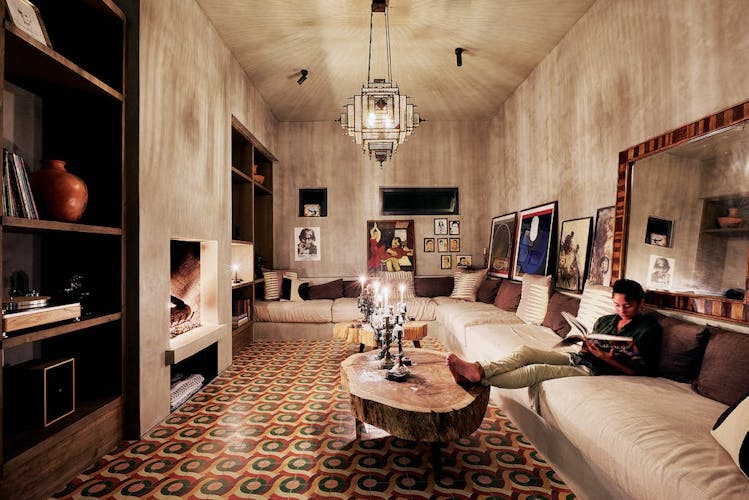
The Tile at the Hotel San Cristóbal
For Lambert, the most commonplace moments spark ideas. While waiting for her latte at a cafe in New York City in 2014, she looked around and was taken by the tile pattern on the counter. It had a colorful Mexican modernist feel she’d been imagining for her latest project, the Hotel San Cristóbal, in Todos Santos, Baja, Mexico. Lambert’s design director, Tenaya Hills, tracked down the woman who’d designed the pattern and, after licensing it, Bunkhouse consigned tile in a different color scheme: green, yellow, maroon, red, and pale pink. The punchy tiles now line the walls, floors, and yoga deck at the 32-room hotel designed by the architects at Lake Flato. Lambert and her team trekked across Mexico to source everything from the furniture to the light fixtures—hunting in Guadalajara, Mexico City, Oaxaca, and numerous places in between—to create a beachfront inn that plays to all the senses, with sweeping views of the water, scents from the fragrant palo santo wood that burns around the pool at dusk, and mellow sounds from the playlist.
The Cars at the Bunkhouse Hotels
Lambert often selects a “hero vehicle” for each property. The red 1973 International Scout II at the Hotel San José was Lambert’s personal car in the early years; these days, it’s used to ferry guests to and from the Austin City Limits Music Festival. A dark silver seventies-era Citroën at the Hotel Saint Cecilia, in Austin, was a gift from Adam Greenfield, a man Lambert met on a design panel. “He was leaving the country for a job and said that he thought it would be perfect for the Saint Cecilia,” Lambert says. “And he was right. I wish every hotel could have the car of its choice. The Havana would have a beautiful old Chevrolet.”
In addition to the cars, most of Lambert’s hotels also have an artistic muse. At the Hotel Havana, in San Antonio, it’s Ernest Hemingway, chosen because of his love of hotels, Cuba, and all things Latin (“And he loved to drink,” Lambert adds). At the Phoenix Hotel, in San Francisco, it’s Kurt Cobain. “He is a representative of a period of time and feeling that we are trying to capture,” she says. “Nirvana stayed at the hotel regularly.” At the Austin Motel, in Austin, Ann Richards isn’t necessarily the property’s patron saint (“Although I would like to consider Ann my own personal patron saint,” she says), but the former governor did inspire a drink on the menu: Ann Richards’s Revenge, a mix of rums, apricot syrup, and pineapple and lime juices.
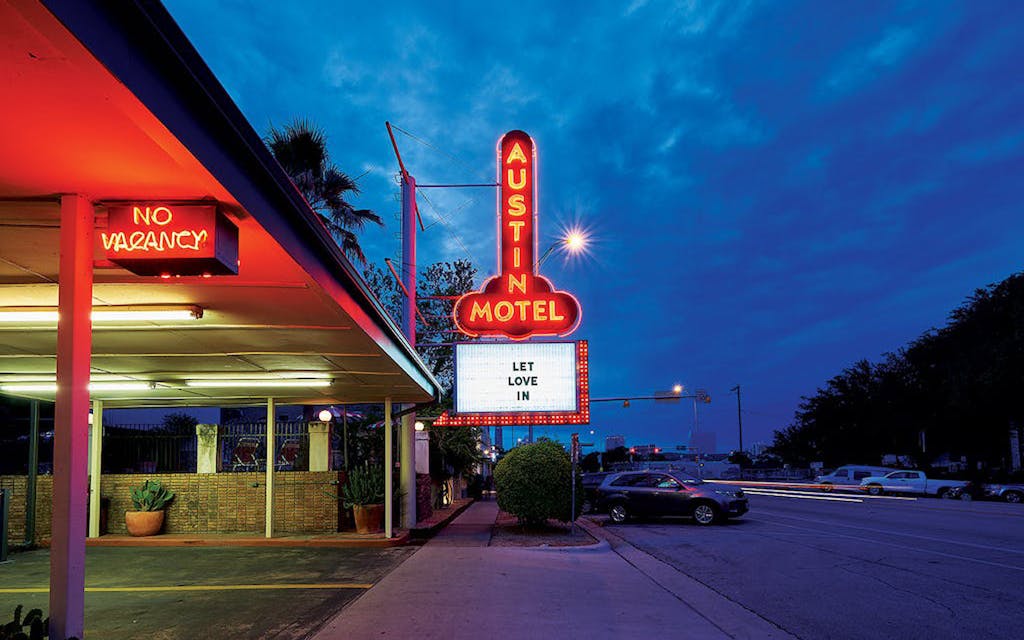
The Sign at the Austin Motel
While almost everything at Lambert’s recently reopened Austin Motel revolves around the 1,100-square-foot kidney-shaped swimming pool, the most memorable design element at the funky South Congress property is undoubtedly its vertical neon sign, shaped in such a way that the hotel has been forever branded “the phallus palace.” A more prudish owner might have replaced the insignia with something more modest. But Lambert doubled down on the silhouette, making it the motel’s logo and printing it on inner tubes, kids’ arm floaties, koozies, lighters, and T-shirts. Lambert says the sign’s curves even influenced her decision to incorporate rounded edges in the design of the red vinyl sleigh beds and the bookshelves’ corners.
The Robes at the Hotel San José
Lambert decided the Hotel San José was “mature enough” in 2007 to warrant a custom robe, and it wasn’t going to be a run-of-the-mill piped-waffle weave. Casing the property for a signature look, her eye fell on the colorful vintage serape blankets she had collected for years. Within months, she’d commissioned San José robes made out of custom-designed fabric inspired by the serapes. These days, all the Bunkhouse hotel have their own kimono-style robes.
The Color Blue at the Hotel Saint Cecilia
Each of Lambert’s properties exhibits a signature color: at El Cosmico, in Marfa, it’s deep yellow; at the San José, in Austin, it’s green; at the Havana, in San Antonio, it’s red; and at the Saint Cecilia, in Austin, it’s a series of blues, which appear in various iterations: lush velvet headboards, the walls of the cozy hotel bar, and the block-print robe.
Long before the hotel opened, in 2008, Lambert hung on her bulletin board in her Austin office an engraving of Saint Cecilia, the patroness of music, painted in shades of blue. When Lambert’s business partner, Greg Marchbanks, started pushing her to share her vision for the Victorian-style mansion and surrounding bungalows so that he could pitch the concept to potential investors, she looked at her bulletin board and proclaimed, “It’s the Saint Cecilia—she’s the patron saint of the arts, and that’s what this place is going to be about.”
The palatial accommodations combined with a music theme triggered Lambert’s memory of photographs she had seen documenting the Rolling Stones’ stay at the Villa Nellcôte, the French mansion where rock and roll met plush luxury in the ultimate house-party setting. By the time decorating was complete, the appreciation for music was on full display throughout the estate: record collections in each of the fourteen rooms; a piano in Suite 5; music posters on the walls.
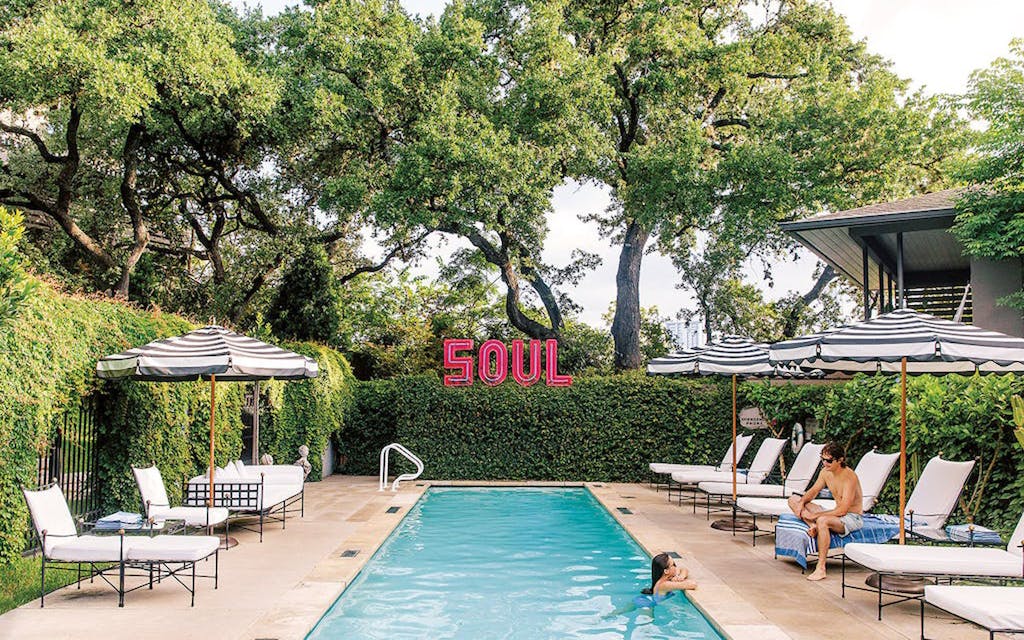
The Soul Sign at the Hotel Saint Cecilia
When Lambert was in the design phase of the Hotel Saint Cecilia, in 2006, she was walking between her hotels on South Congress Avenue and stopped in her tracks. A neon sign read “soul,” in capital letters, in the window of the clothing store Blackmail, co-owned by couture designer Gail Chovan along with her husband, Evan Voyles, Lambert’s friend and longtime collaborator. Voyles had discovered the four-foot-tall red porcelain letters, which had originally been part of a set that spelled out “Louisiana,” in a dilapidated casino along the Texas-Louisiana border. (Unbeknownst to Lambert, Voyles bought the letters thinking his friend and restaurateur Lou Lambert, Liz’s brother, might want to use them to open a restaurant called Lou’s at some point.) Lambert had no idea where the sign would hang at the hotel, but buying it felt right. “It was a funny day when the design team and I were walking around from place to place around the Saint Cecilia, trying to figure out where to put it. People were hesitant about my idea to put it right above the pool, but it turns out that was exactly where it was supposed to go.” The sign has become the defining object—and the most Instagrammed—of the hotel.
The Ocho Sign at the Hotel Havana
Back in 2007, when Lambert was in the midst of making over the Hotel Havana, along the San Antonio River Walk, she was strolling the aisles at the Round Top antiques fair, and there it was: an early-1900s two-by-five-foot sign, ringed with light bulbs, spelling out “ocho.” Thinking of the lively street in Havana called Calle Ocho, she bought the sign and decided to use it as the name of the hotel’s restaurant.
The vivid blue sign was the key to creating the hotel’s color scheme. “We used some photos of Havana in the fifties as inspiration and recovered all the existing furniture in the 103-year-old hotel using a color palette of reds, oranges, maroon, deep greens, and blues,” Lambert says. After painting the inside of the restaurant turquoise, she brought in a blue velvet banquette and white-marble-topped tables that sit under vintage chandeliers.

The Rugs at the Bunkhouse Hotels
Brightly colored Moroccans, flat-woven kilims, overdyed vintage dhurries—every space has a rug that looks as if it was designed for it. And sometimes the rugs are custom made, like the ones in the Hotel San Cristóbal, which were created by Trine Ellitsgaard, a Danish artist who has spent the past twenty years living in Mexico and who took Lambert to the city of Oaxaca to work directly with her weavers. For the other properties, Lambert has “a guy,” as she often does, a dealer who drives up to whatever latest project she has with a box truck filled to the brim with rugs in a variety of sizes that he thinks Lambert will like. “On installation day at the Saint Cecilia, we spread them across the grass under the oak like a carpet,” she says. “At the Havana, we covered the parking lot in rugs and then we ran them inside and tried a rug in a place and then another and another until we found the right spot.”
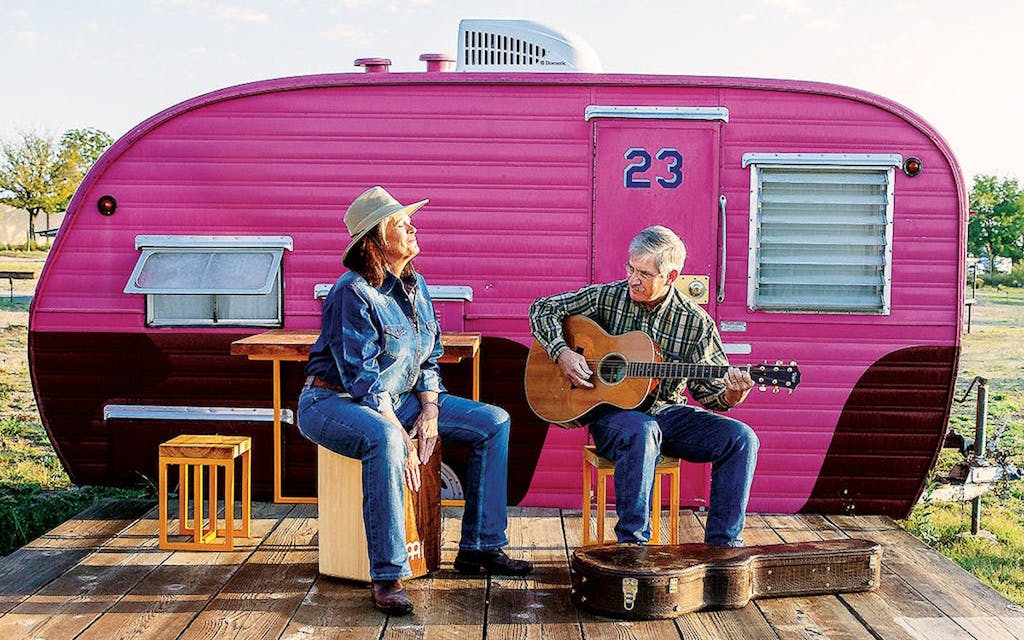
The Trailers at El Cosmico
How do you make a hotel materialize in a bare pasture in the high desert? Lambert bought 21 acres out in Marfa in 2006 but didn’t build on the land until her vision for the project finally crystallized years later, when she decided it would be a place where Eastern spirituality would meet the myth of the American West. “After working on the Thunderbird and then walking away from it—it turned out to be not a great partnership—I realized that if I could do it all over again, I would create a place to be outside as well as inside, so you could look at the stars,” Lambert says.
Ten vintage trailers moor the property, which includes a lobby building and a teepee-filled campground. But the unusual configuration of rooms alone isn’t what sets the place apart. When designing the interior of the trailers, Lambert was influenced by forms of transportation like boats and Indian jitneys. The shiny birch veneer on the trailers’ interior walls suggests the inside of a yacht.
Disclosure: Texas Monthly chairman Paul Hobby is a minority investor in one of Lambert’s new properties, the Magdalena.
- More About:
- Style & Design
- Architecture







